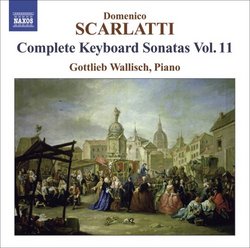| All Artists: Domenico Scarlatti, Gottlieb Wallisch Title: Scarlatti: Complete Keyboard Sonatas, Vol. 11 Members Wishing: 0 Total Copies: 0 Label: Naxos Original Release Date: 1/1/2008 Re-Release Date: 10/28/2008 Genre: Classical Styles: Chamber Music, Forms & Genres, Sonatas, Historical Periods, Baroque (c.1600-1750), Classical (c.1770-1830) Number of Discs: 1 SwapaCD Credits: 1 UPC: 747313046874 |
Search - Domenico Scarlatti, Gottlieb Wallisch :: Scarlatti: Complete Keyboard Sonatas, Vol. 11
 | Domenico Scarlatti, Gottlieb Wallisch Scarlatti: Complete Keyboard Sonatas, Vol. 11 Genre: Classical |
Larger Image |
CD Details |
CD ReviewsToo detached Eloi | Ely, NV USA | 02/17/2009 (4 out of 5 stars) "Rare for the Naxos series, this recording begins with one of the pairs evident in the two main sources, and K 472/473 work well together, 473 the livelier of the two. Wallisch uses pedal discreetly in overly articulated performances. The same might be said for the recording as a whole, but the well-known K 64 is more expressive. In another "canon" sonata, K 462, Wallisch brings out the lines well but has nothing new to say and demonstrates an inability to play ornaments on the beat. Well, neither could Kirkpatrick, so no fatal flaw there. Wallisch's performance of K 545 is revealing, especially in comparison with wild man Pinnock's version. I cannot fault Wallisch in rhythm or tempo. But there's an animal vitality to Scarlatti that Wallisch doesn't seem to grasp. The recording contains a couple of well-performed rarities in a theme and variations (K 61) and a fugue (K 54)--the rest are the usual binary sonatas. I notice that Naxos is now including the Kirkpatrick, Longo and Pestelli numbers for the sonatas. What's next, Fadini numbers? Moscow Conservatory numbers? Let's give Longo credit for being first and retire the others--who needs 'em? " Another in Naxos's Series of the Complete Scarlatti Keyboard J Scott Morrison | Middlebury VT, USA | 10/28/2008 (4 out of 5 stars) "Gottlieb Wallisch is a young Austrian pianist, just now thirty, who has turned in some creditable recordings of Schubert piano sonatas on the Naxos label. I particularly liked this one -- Schubert: Piano Sonatas Nos. 1, 8 & 15 'Reliquie' -- that contains the 'Reliquie' sonata and this one -- Schubert: Piano Sonatas Nos. 5, 7a, 11 & 12. I was a little less impressed with this one -- Schubert: Piano Sonatas Nos. 2, 3 & 6 -- largely because it contained primarily early, and less distinctive, sonatas by Schubert. Now Wallisch appears again, this time in Volume 11 of the ongoing Naxos series of the complete keyboard sonatas of Domenico Scarlatti. It is to Naxos' credit that they have selected a different pianist for each volume and in the process have introduced us to some fine young and heretofore unknown pianists. I have been particularly thankful that they selected Soyeon Lee, a young Korean pianist, for one of these volumes -- Scarlatti: Complete Keyboard Sonatas, Vol. 8. She is surely destined to great things.
This volume contains primarily less-familiar sonatas. It strikes me that Wallisch is more comfortable, or perhaps more psychologically attuned, to the slower minor key sonatas, such as the G Minor, K.347 and the F Minor, K.462. He also turns in an effective performance of the lovely 'cantabbile' (sic) C Major Sonata, K.384. It is, however, in the fleeter, lighter sonatas that he satisfies less. This is not necessarily because of any technical deficiency, although his touch is a bit heavy for some of them and he tends to convey a rather romantic nineteenth-century view, but is perhaps more due to the sound of the piano itself. Whatever the reason, I found myself wanting to hear the slower sonatas again and being tempted to skip over the faster ones. (It is entirely possible this was due to my mood, but I had the same reaction as I was listening again several days later.) For these reasons I am less willing to give an all-out recommendation for this volume. If you are collecting the entire Naxos series you will of course want this one. But if you are just dipping into the series to get a taste of Scarlatti, I'd strongly recommend either the Soyeon Lee or the Benjamin Frith volume Complete Keyboard Sonatas 5. Scott Morrison" |
